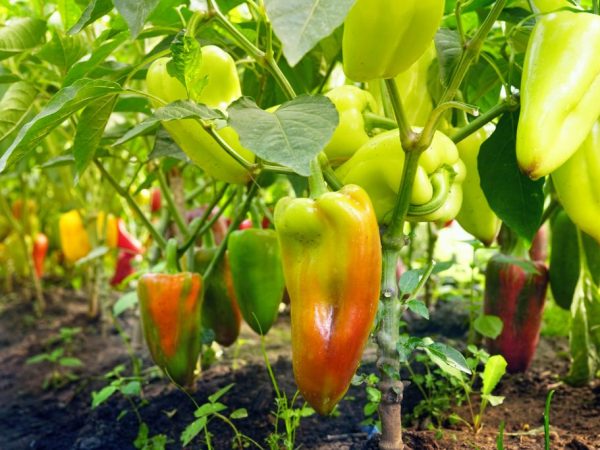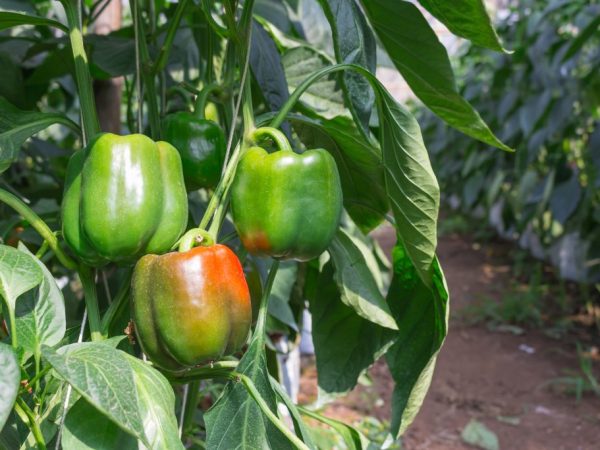The best peppers for polycarbonate greenhouses
Both early and late varieties of peppers for a polycarbonate greenhouse are chosen. The main thing is to comply with all the care requirements in order to get a high-quality crop.

The best peppers for polycarbonate greenhouses
Features of polycarbonate greenhouses
Recently, polycarbonate has been increasingly used as a material for the construction of greenhouses, since it retains heat better than glass. This is especially important if the pepper is grown in a region with a changeable climate.
Polycarbonate is quite flexible, this allows you to create greenhouses of different shapes and types: in the form of a sphere, with a hemispherical roof, etc. Also, this building material is resistant to mechanical damage and weather conditions (strong winds, showers, hail).
Variety selection
Careful selection of the correct seeds is an important criterion when growing vegetables. For planting peppers in greenhouse conditions, you must select the seeds intended for this.
There are several features for choosing a variety:
- Growing conditions. Pay attention to the size of the greenhouse. Initially, it is determined which plant you need: short or tall.
- Ripening terms. Clarify what is needed: early or late grade. If the size of the greenhouse allows, both varieties can be purchased.
- Diseases. They find out what diseases and pests vegetables in the region are most susceptible to, and select species with increased immunity to these ailments.
It is important to consider the lighting needs of some varieties. If there is a backlight in the greenhouse, you do not need to worry about this, otherwise it is necessary to install phytolamps: they provide light radiation and heat that the seedlings need.
Not only lighting, but also the plant's belonging to another region can become an obstacle to fertility. Even in a fully stocked greenhouse, it is impossible to grow species destined for a different area. It is best to purchase materials for planting in seed land.
It is important to clean the greenhouse every fall. Late vegetables are usually dug up and transplanted into large pots to grow at home. This method will extend the yield until mid-winter.
Hybrid and true variety
If a hybrid labeled F1 is grown in a greenhouse, it makes no sense to extract seeds from it. In such plants, fruit qualities are not extended by several plantings. This is a disadvantage as new seeds have to be bought every year.
But there are advantages: hybrids are good with high yields, as well as good resistance to many diseases.
The advantage of these varieties is that they can be re-grown for many years (the exact value depends on the specific variety). They are usually not whimsical to growing conditions, resistant to temperature extremes and high humidity. The main disadvantage of this variety is its unstable yield.
Features of growing pepper in a greenhouse

Follow the recommendations
When choosing the best seeds for a greenhouse, it is important to study all the features of growing plants in this way:
- The soil needs preliminary preparation before planting seedlings. Garden soil must be mixed with humus or peat and sand.
- Water is supplied to the plants artificially (rain bays do not take part in cultivation), so the soil needs to be fed. It is fertilized 3-4 times a season.
- When planting varieties of pepper for the greenhouse, they make sure that sweet and spicy self-pollinated varieties of such a vegetable do not grow nearby, since pollination may occur and the taste of the fruit may deteriorate.
- It is necessary to plant vegetables at a depth of at least 20 cm and at a distance of 40 cm from each other.
In a polycarbonate greenhouse, at least 1-2 windows must be made; in hot weather, it must be ventilated so that the plants do not dry out. The vegetable is sensitive to high temperatures and dry air, and if agricultural technology is violated, even the best varieties of greenhouse salad peppers will not give a high-quality harvest.
Variety of greenhouse varieties
Modern selection is rich in various types of greenhouse peppers, distinguished by good taste, appearance and high yield.
Best Salad Pepper Seeds for Greenhouse with Names and Descriptions:
| Name | Description |
| Atlant | A tall type of red pepper, it has good yields in different types of soils. The average height is 80 cm. The vegetable is large in size with a mass of 80-150 g. The taste is classic, the pulp is juicy. The period from germination to maturity is 110 days. The species is ideal for greenhouse cultivation in polycarbonate premises. |
| Alyonushka | The vegetable is hybrid. Among the mid-early, he is considered one of the best. The height of the bush reaches 1 m. The shape of the fruit is pyramidal. Ripening lasts from 100 to 130 days. |
| Prince Silver | Early maturity vegetable - up to 100 days. Bushes of medium height - about 80 cm. The shape of the bushes is neat. Fruits are conical, smooth-walled. The pulp is juicy. Average weight - 95 g. Prince Silver is resistant to ailments. It can be planted near hot peppers. |
| Orange miracle | Early variety. It ripens within 90 days after planting. The color of the ripe vegetable is orange. It is larger in size than medium vegetables (150 g). The flesh is firm and not particularly juicy, with a thick skin. The variety has good storage performance. |
| Hercules | The vegetable reaches ripeness after 130 days. The height of the bush is 60 cm. Fruits are cubic in shape with smooth walls, sweet taste. The average weight is 140 g, and the maximum weight is up to 200 g. The color is red when ripe. The vegetable is resistant to infections. |
| California miracle | The color of the variety is bright red. The vegetable has excellent storage performance. The species is not suitable for cultivation in the northern regions. |
| Arsenal | The bushes are medium-sized: their height is about 70 cm. They are distinguished by high fertility. They are tapered. Weight reaches 120 g. It is planted near sweet varieties. |
| Pinocchio | Ripens within 100 days. The shape of the fruit is cone-shaped, elongated. The color of the fruit is pale red. Weight - 150 g. Medium-sized bush, 100-120 cm. |
| Golden Tamara | The fruits of this variety are of an unusual shape, more like tomatoes. The size of the vegetable is one of the largest - up to 200 g. The pulp is fleshy, sweet, juicy. The fruit tastes like a bell pepper. The walls are of medium thickness - about 9 mm. The height of the bush is about 90 cm. This species is the earliest: it ripens in 90 days. The vegetable is good for conservation, resistant to many viruses. |
| Swallow | Mid-season species. Has a sweet taste. The color of the fruit is red. They are tapered. Full maturation occurs 120 days after planting. High bush - 130 cm.Medium vegetables - 150 g. |
| Cardinal | The height of the bush is more than 1 m. The variety is late-ripening, but high-yielding. The fruits are large (200 g), juicy, thin-skinned. By the end of the ripening period, the fruit acquires an eggplant color. |
| Winnie the Pooh | Early maturing view. Ripening - up to 100 days. Fruits are conical in shape. The color is red with yellowish flashes. The mass of the vegetable is about 170 g.It is characterized by short storage time. The skin is thin in structure, juicy, with loose flesh. The height of a medium-sized bush is up to 65 cm. |
| Claudio | Hybrid Dutch variety. Early ripening fruits ripen in a period of up to 130 days. The largest fruits reach 250-300 g. At the final stage of maturity, the color acquires a brownish-red hue. The shape of the vegetable is standard, with a shortened tail. The bush is voluminous, 140 cm high. The variety has good storage performance, is immune to various diseases. |
Care features
Each variety, regardless of its characteristic immunity to disease, needs good care. It includes:
- planting seedlings;
- planting in the greenhouse at the appropriate time;
- control over the level of moisture in the greenhouse and soil;
- regular fertilizing with fertilizers.
In case of falling blooms, pay attention to the moisture level. Such a reaction can occur due to waterlogging or due to dry air. For one bush, 300-500 ml of warm water is enough.
Peppers can be damaged by Colorado beetles, May beetles and aphids. It is necessary to protect the greenhouse plant exclusively with the biological preparations "Fitoverm" and "Lepidocide". They are good because they do not contain chemical poisons. If you add phosphorus or potassium fertilizer to the care, this will prevent the reproduction of aphids.
Conclusion
The high yield of greenhouse peppers is achieved through the correct selection of seeds and careful care of them. It is important to pay attention to the characteristics of each vegetable separately in order to choose the right variety for a polycarbonate greenhouse.


